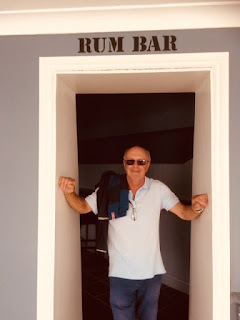Our first visit was to Knighthayes Court, a jewel of a National Trust property less than ten minutes from the M5. The building was designed by William Burges, a well-known Victorian eccentric, so it looks part medieval, but also has lots of Gothic revival features and is set in lovely rolling parkland, with woodland walks and gardens to stroll through. There is also a well used walled garden for those who are more interested in the vegetable side of gardening. I was sad to see that the wonderful hedgetop topiary, of the dogs chasing the fox, is now old and could do with being restored. The house itself is very interesting with great detail work in all the rooms, even the original owners, Heathcote Amory, were overwhelmed by the complexity and imagination of Burges's designs, and appointed another architect to tone it down. My favourite was the billiards room ceiling-line carvings of the animals representing the Seven Deadly Sins. Look up at the seven deadly sins looming over the billiard table; From the violent wolf to the greedy pig, these imaginative stone carvings are watched over by the wise owl - fabulous.
The gardens are very pretty, with a long view down to Tiverton in the valley.
The following day we visited Little Switzerland. The small, unspoilt towns of Lynton and Lynmouth are situated on the northern edge of the Exmoor coast. Lynton stands some 450 ft above its sister village of Lynmouth and in the 18th and 19th Centuries inspired Romantic poets and authors and became a popular tourist resort owing much of its development to the wealthy publisher, Sir George Newnes. Lynmouth is also famous for The Lynmouth Flood on 15th August, 1952. After days of torrential rainfall over Exmoor, accumulated flood water forced its way down the narrow valleys of the West and East Lyn rivers, which converge at Lymouth. The surge brought with it trees and boulders which dammed the rivers causing the waters to burst through with devastating consequences. Overnight, over a hundred buildings were destroyed or damaged beyond repair along with 28 of the 31 bridges which spanned the two rivers.
The twin towns of Lynmouth, at sea level, and Lynton, considerably higher, are linked by a unique Victorian water-powered Cliff Railway, a steep and scenic journey lasting just a few breath-taking minutes.
The railway consists of two cars, each capable of transporting 40 passengers, joined by a continuous cable running around a 5 ft 6 in pulley at each end of the incline. The cable below the upper car counterbalances that supporting the lower car, which weighs several tons, thereby keeping the two sides in equilibrium, +/- the weight of the water. Water feeds through 5 inch pipes from the West Lyn River - over 1 mile away - into tanks under the floor of the upper car. Each car has a 700 imperial gallon tank mounted between the wheels. Water is discharged from the lower car, until the heavier top car begins to descend, with the speed controlled by a brakeman travelling on each car. The parallel 3ft 9 in gauge tracks (which bow out at the centre point, to allow the cars to pass) rise 500 feet and are 862 feet long, giving the line a gradient of 1:1.724 (58%). The lifts need absolutely no power to operate, water is its motive power. The company is permitted to extract the water following an act of Parliament formed in 1888. The water used is not altered, damaged or polluted in any way, just used as ballast and discharged onto the beach at Lynmouth about 100 metres away from the river from which it was taken. As the water is not re-pumped to the top then no other machinery or fuel is required. The lifts do not create any emissions, even the brakes are powered by water, and the carbon footprint today has not significantly changed in the last one hundred and twenty years. The Lynton and Lynmouth Cliff Railway remains one of the most environmentally friendly tourist attractions in the world.
There is no doubt why the Victorians named the area "Little Switzerland" - the alpine topography is stunning. Rolling moorland tumbles down into wooded valleys alongside the fast flowing East and West Lyn Rivers which rush out to sea, whilst on either side some of England's highest sea cliffs provide a dramatic backdrop.
We then drove on to the Valley of the Rocks. A dry valley that runs parallel to the coast about 1 kilometre to the west of the village of Lynton. We looked hard for the feral goats but only managed to spot actors and drones filming Brittania for Sky.
Absolutely incredible views and there is an easy path right on the cliff edge.
We then drove on to the charming village of Porlock Vale, surrounded on three sides by the glorious hills of Exmoor National Park and on the fourth by the sea. Please do not throw pebbles into the harbour!!!
Thank you so much for all your driving John and for an excellent couple of days. We really enjoyed our visit.
On the way home we stopped off to see some more friends, Alan and Janet, who have also moved to Somerset and had a relaxing lunch in their garden.
So lovely to catch up with old friends.



































